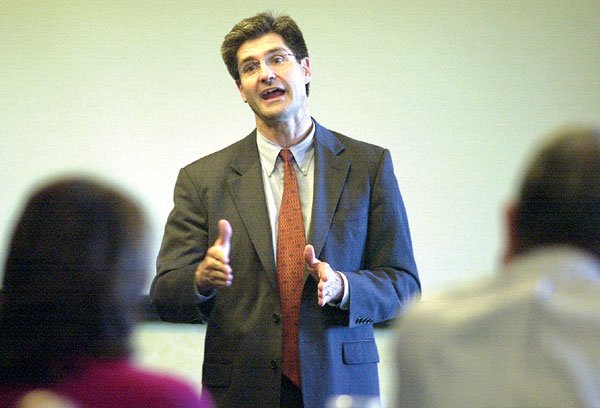MORGAN HILL
– Despite statistics that show the dreary state of the economy
and education since the high tech
”
bubble
”
burst nearly three years ago, Silicon Valley Manufacturing Group
CEO Carl Guardino is cautiously optimistic about the future.
MORGAN HILL – Despite statistics that show the dreary state of the economy and education since the high tech “bubble” burst nearly three years ago, Silicon Valley Manufacturing Group CEO Carl Guardino is cautiously optimistic about the future.
Guardino addressed a group of Morgan Hill business leaders gathered at the Golden Oak Restaurant Friday afternoon for the Morgan Hill Chamber of Commerce’s quarterly Big Business Forum. He believes the secret to the future success of Morgan Hill and the entire Silicon Valley are partnerships between private and public representatives working to find answers to the challenges that the region and the entire state face.
“Trends are not destiny,” he said. “We can determine where we will be in the future, if we have groups like this one, made up of public sector and private sector working together.”
While detailing depressing statistics about the region’s economic situation, Guardino said he was giving the information not to overwhelm people with negative news but because he thinks it is important to know what challenges are to be faced.
“If we have a sense of where we’re going, tackling those challenges is easier,” he said. “I would rather have a road map that shows the potholes and speed bumps ahead.”
Mayor Dennis Kennedy and Councilwoman Hedy Chang and Councilman Larry Carr attended the gathering along with local banking executives, representatives from area businesses, including Abbott Labs, Anritsu and Wellington Corp. Guardino distributed copies of the SVMG-created “Projections: 04,” a publication examining housing, transportation, education, environment and energy in the Silicon Valley.
Guardino, a San Jose native, told the gathering that though the last three years have been devastating, he believes the area is on the verge of an upswing.
“The next wave of innovation has always been what has saved us here,” he said. “We have a higher probability of coming out of this if we continue to partner public and private and foster our economic climate. We could set the stage for nanotech and biotech or whatever technology is on its way.”
The Silicon Valley Manufacturing Group is studying ways to improve the business climate to keep manufacturing businesses in California.
“We’re trying to determine what we can do to stay competitive,” he said. “We’re creating a business climate survey which will provide quantifiable data of what businesses need. We’ll ask did they add jobs or lose jobs in the last year, and if they lost them, are they temporary or gone for good … what are the strengths and what are the challenges of doing business in Silicon Valley.”
A particular concern of Guardino and the SVMG is education.
“We see education as our number one challenge and opportunity,” he said.
One of the biggest challenges facing Morgan Hill and most of the Silicon Valley, said Guardino, is affordable housing and qualified teachers.
The districts with students scoring highest in state aptitude tests, he said, are districts with the highest percentage of certified teachers. Not coincidentally, those districts are also the districts with the wealthiest residents, he said.
“We see a link between how kids perform and how many teachers are qualified and credentialed,” he said.
The recently enacted federal “No Child Left Behind” mandate is a great goal, he said, but may not be very useful in helping Morgan Hill students improve.
“It has no carrots, but lots of sticks,” he said. “There is no money behind it to support it; in fact, you can lose money if you don’t meet the requirements.
“The challenge we face of improving the quality of our education is exacerbated by a core strength of our valley, and that strength is diversity. One of every four kids is an English language learner … We have 56 different languages among our students.”
Teachers are not the only ones who need affordable housing, he said. Many who work in the public sector – police officers and firefighters for example – often cannot afford to buy homes in the cities where they work.
“People have to live further and further out,” he said. “The median price of a resale home is $520,000 in Santa Clara County. Only one in four first-time homebuyers can afford this.”













